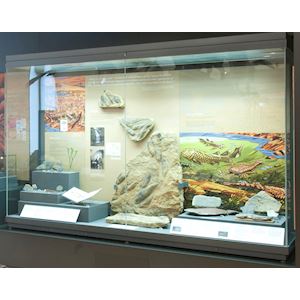
04. DURA DEN FOSSILS IN LANDSCAPES AND LIVES
This important collection of fossils was discovered in 1859 at Dura Den, near Cupar in Fife. The Dura Den site is important, because all of the fossils are complete, and have all been removed from the site. Today, examples of Dura Den fossils can only be found in museums and private collections. All of the fossils found in this region are from the Devonian Period, about 410 million years ago. Most of life in the Devonian period lived in water. This included many different types of fish and a large lobster-like arthropod called a eurypterid (yu-rip'tu-rid) (or sea scorpion). You can see some examples of these water-dwelling creatures in object number 24 (which is a reproduction) and fossilized examples, which are object numbers 25 and 26) in the right hand case. Many species of fish from this period are now extinct, including Acanthodians (Ak-anth-oad-i-ans (spiny sharks), placoderms (plate-skinned fish), Cephalaspis, (Keff-all-asp-is)(head-shield fish), lobe-fin fish and ray finned fish. Only descendants of two types of fish from this period on display survive today: the lobe-finned fish – like the one you see here at object 17 - and ray-finned fish – which are the types of fish fossils you see at objects 14 through 16. The Devonian period was also the time when complex life first appeared on land. These early life forms are represented by fossils of the primitive plant Parka decipiens, (Park-a dek-ip-i-ens) which you can see at object numbers 1 and 2, the early plants Rhynia (Rine-ee-a), which are object numbers 3, 4 and 5 and Psilophyton, (Silo-fight-on) which are numbers 8, 9 and 10. Look at objects 6 and 7, the Kampecaris forfarensis. (Camp-ee-car-is)These are a relative of the millepedes, and Kampecaris forfarensis (Camp-ee-car-is may have been one of the earliest land animals. In the case to your far left, locate object number 1, a rare Woolly Mammoth tooth, which was found in Scotland. When you’re ready, please walk to the log boat, to the left of the entrance of this gallery.


The McManus: Dundee's Art Gallery and Museum
The McManus: Dundee’s Art Gallery and Museum is situated in the centre of Dundee. The Museum and Art Gallery originally known as the Albert Institute was opened in 1867 as a memorial to Prince Albert. In 2005 The McManus closed for a major refurbishment, reopening again on the 28th February 2010. We celebrated our 150th Anniversay in 2017 with a year of celebration. In 2020 we were awarded Visitor Attraction of the Year by Visit Scotland. The McManus has 8 galleries, which are laid out on 2 floors. Visitors can embark on a journey through 400 million years, and witness how a small settlement developed into the City of Dundee as it is today. From exhibits relating to the life of early man in the area, stunning paintings and decorative art through to artefacts from industries past and present, the City's collections, many of which are recognised as being of national significance, give an insight into Dundee and its people.
- The McManus: Dundee's Art Gallery and Museum
- Dundee United Kingdom
- www.mcmanus.co.uk
